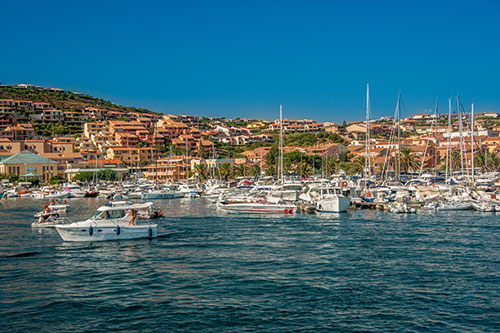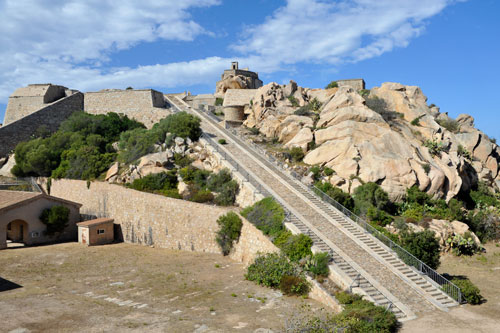Costa Smeralda, Palau and surroundings
map of Costa Smeralda, Palau and surroundings
Costa Smeralda

In the 1960s, the billionaire Aga Khan built here an exclusive holiday paradise for the super-rich people of the world.
That was the beginning of tourism on Sardinia. Hotels and holiday resorts suddenly emerged everywhere on the “forgotten island”.
The beauty of the “Emerald Coast” attracted numerous investors and, up to the 1980s, the Costa Smeralda was permanently visited by celebrities. Today, you rarely meet Hollywood stars, singers and others. The trend has long been towards high-end tourism for package holidaymakers.
The hotels, holiday homes and restaurants are the most expensive ones in Sardinia. There are no large beaches, but there are dreamlike little bays. Most of them can be reached only by boat.
A visit here is nevertheless worthwhile, because the landscape is really beautiful and the villages invite you to stroll around with their felicitous architecture.
Porto Cervo (photo) with its church “Stella Maris” and its marina is particularly worth a visit.
Monte Moro

This mountain in the hinterland of the Costa Smeralda is relatively unknown to tourists. It offers fantastic views of the entire Costa Smeralda, the Gulf of Arzachena and the archipelago of La Maddalena (photo).
The rounded granite rocks of Gallura rise out of the green of the macchia and trees and form a magnificent backdrop against the deep blue sea and the offshore islands.
An access road branches off from the main SP 59 road and later becomes a dust track that winds up the mountain via serpentines roads and is passable to some extent. The track leads up to the summit. Here there are several transmission masts on the rocks.
The platforms on the rocks are great and free accessible viewpoints.
To get here, a car with the usually ground clearance and a careful driving style are sufficient. I would not recommend the trip for motorhomes.
Capo d’Orso

The “Bear’s Cap” is one of the most popular sites for taking pictures in Sardinia. The photo on the right is indeed a historic one, because today it’s strictly forbidden to climb this rock.
At the bottom there is a chargeable car park, then you pay an entrance fee and are allowed to walk up the newly built path.
At my last visit, everything on the summit was surrounded with railings and barriers, which were unfortunately placed in a that way that you could only photograph the “bear” from behind.
Nevertheless, it is worth coming here for the bizarre rocky landscape and the beautiful view of the Bay of Palau and La Maddalena.
Palau

This little harbor town has developed into one of the biggest tourism centres in Sardinia. A lot of new holiday resorts and hotels have been built in the surroundings during the last years.
Palau is a modern village, which offers the tourists a good choice of services with its restaurants, several hotels, shops and even a marina. The bathing facilities in the near vicinity are also great.
Most of the tourist boats, which ship to the islands in the National Park Arcipelago di La Maddalena, start at Palau’s harbor.
Depending on the season, car ferries with direction to La Maddalena leave up to 80 times a day. The shuttle takes approx. 15 minutes.
During the tourist season the narrow-gauge railway Trenino Verde “Gallura” runs to Tempio Pausania on some weekdays.
La Maddalena

The group of islands is easily accessible by ferry, which also transports your car. However, only the main island and a few parts of the neighboring island Caprera are drivable. All the other islands of the Arcipelago di La Maddalena are reachable only by excursion boats, which make stops at the beautiful beaches.
On Caprera is the country house of the great Italian folk hero Giuseppe Garibaldi, who fought for the national unification of Italy and the annexation of Sardinia. He retired on Caprera and was also buried here.
Today, the estate is a museum. During the high season, you almost always have to expect longer waiting times due to the rush. Sometimes recruits are sworn in here and for many Italians a visit is almost obligatory.
On the main island of Maddalena, magnificent panoramic roads lead both along the coast and into the interior of the island.
The town of La Maddalena is the only major settlement on the islands. Even during the high season, the atmosphere here is still relatively calm and the small town invites you to stroll around with its nice historic centre.
Punta Sardegna

The headland west of Palau with its little bays is one of the most charming places on the north coast.
There are plenty of small coves down the sea.
From the rocks of the hilly peninsula, there are always beautiful views of the picturesque coast and of La Maddalena.
Fortezza di Monte Altura

The coastal fort “Fortezza di Monte Altura” is located on the highest point of the headland.
Due to its strategical position, the archipelago of La Maddalena had been repeatedly the target of conquerors. In 1793, the French unsuccessfully tried in vain to occupy the islands. Admiral Nelson had his headquarters here during the Anglo-French War of 1803-04.
When the nation state of Italy was formed, it people feared new conflicts with France and built fortifications here on along the coast and on the offshore islands.
This fortress is the only one that has been partially restored and can be visited today. Originally, the whole complex was fit into the rocks so that it could not be detected from the sea.
The 10 cm cannons set up at the time could have fired as far as Corsica, but they’ve never been used. During the Second World War, the fortress was converted for anti-aircraft defence.
The crew compartments and ammunition bunkers can be visited on a guided tour. A supply ramp leads to the former gun emplacements.
